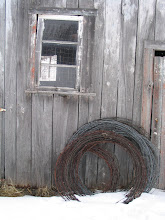The paint is finally done in Eric's office. We ended up hybridizing a Benjamin Moore colour called Versailles:
The wonderful Lea at Centre Decor Hudson is a paint PRO. I've heard of Lea through the community grape-vine, but we've never patronized her paint shop until now. Wow, were we impressed! She's a real artisan and managed to capture Eric's wish perfectly. We both love the result. Lea managed to balance the strength of blue and purple so that neither colour was dominant. What's unfortunate is my inability to capture the colour properly with my camera! It's far too blue in the photos further below, but it's all I've got!
Hark! What do we have here? We're about to find out! And once again, this photo drives home the point WHY we're repainting the floor instead of leaving it au naturel. There are so many holes, dents, scratches, pings, patches, etc., that natural beauty is obscured by years of abuse.
Oh well. Gee. A nice groove cut into the floor. For what, we've no clue. Maybe electrical wiring? Maybe some sort of prehistoric plumbing attempt? In our house, from our experience, anything is possible. We've seen it all. Eric is going to clean it out, countersink the nails that broke off, sand it to the level of the rest of the floor, fill everything in with epoxy (Eric's specialty), and once it's painted white, you'll never know it was there.
Note the red lid beside the small crowbar and broom in the photo below. We have no clue what was here once, perhaps a toilet, but it's yet another hole that needs to be repaired. Eric is going to make a plug out of wood for this, and ordered a 1/2" rabbet set from Lee Valley, so I'll be sure to post how he goes about fixing this.
When I removed the shellac in the guest room last January, I used a heat gun because the shellac had a nasty habit of splintering. It was easy enough to get a 1" spackling knife underneath the thick coat of shellac, but unless it was softened by the heat gun, it would splinter into hundreds of shards. Here we are in August, and maybe our hot weather softened up the finish a bit, because it was much easier to work with.
Eric treated himself to a new tool which helped our progress in removing the shellac: the Fein MultiMaster. Now, here's a tool we should have bought AGES ago! We were actually fighting over who got to use it! Once our tug-o'-war over the MultiMaster ended, we attacked the floor, and estimated we had the entire finish removed in about 6 hours or so. This is THE TOOL if you're renovating an old house, its uses are only limited by the imagination. Seriously, we were sitting there using it, saying, hey, if only we had this tool earlier, wow, we could have saved ourselves a lot of blood, sweat and tears. (It's not that tragic, just sayin'.)
We bought model FMM250Q, either the special or limited edition version that is currently being marketed by Fein Canada. The Fein MultiMaster is built in Germany, and it's tough. We looked at the comparable Bosch model, but after some research, we were quickly sold on the Fein. They made it first, and they make it best, as far as we were concerned. We own other Bosch tools (I think a huge drill and a reciprocating saw), but the Fein outshone Bosch in the multi-tool department. We are in love!
The tool was not cheap, I think this edition retails for CAD$349, which when our crazy sales tax is added comes to around $400. That's a LOT of money for a tool, but we feel it's worth it given what we still need to do upstairs, in the barns and with our old boat (a thought I need to repress).
Here's a close-up of the blade we used to remove the shellac which came off in sheets we could actually pick up and throw into the garbage bag. Sweet! Seriously, this was the first time we were shouldering each other out of the way to use a tool: LET ME, NO, NOOOOO, I WANNA USE IT, LEAVE IT, LEMMEEEEEE...we were acting like juveniles.
You need hearing protectors to use the tool, but it's not an aggressive sound that will make others in the room run for cover. I could easily sweep up the room while Eric used the tool with hearing protectors. The only caveat both of us noticed is that it's easy to get carried away and use it for an hour or so non-stop, and only when you pry your hand off the tool do you realize the vibration does affect your fingers and hand. I've been operated for carpal tunnel on my right hand so I'm careful with tools; using the MultiMaster was not the least bit uncomfortable, but I wouldn't go using it for, say, a three-hour grout removing marathon.
So, the next step is repairing the carved groove, filling in the 6" hole, plugging three 1" holes, one 2" hole, and a variety of other pings and dents. There was also a lot of plastic wood we removed between the boards that will need to be epoxied. Nothing really major, just time consuming. But we'll get there eventually.
Sunday, August 21, 2011
The Pine Floor - Part Deux
Labels:
benjamin moore,
fein multimaster,
old house,
paint,
pine floor,
refinishing,
renovation,
tool
Subscribe to:
Post Comments (Atom)








4 comments:
I've seen those multi-tools heavily promoted, and always wondered if they were as good as they claim to be. Nice to hear your take on it, and that it worked well for peeling gunk.
I enjoyed your photos from Germany, sounds like a nifty place.
Thanks Ron! We are loving the Fein, it's worth the price and we could kick ourselves for not buying it sooner.
How totally cool! Are your old floors hardwood? Our old wooden floors are soft wood and very warped and trashed. We decided not to go through the hassle of trying to save them.
I wish they were hardwood - they're Eastern true fir, softwood unfortunately. After repairing the downstairs, we covered everything with a layer of plywood because there was so much damage. Upstairs, there's no water damage, just a couple of unfortunately placed holes that we're making plugs for. It's also amazing what you can do with 2-part epoxy! Once we're done, we're going to (oh sacrilege!) paint everything white and cross our fingers the result is acceptable.
Post a Comment